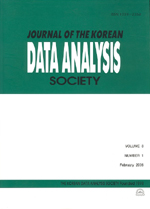의사결정나무 분석을 이용한 기업체 부가가치 비중 산출
A Study of Yielding the GDP Proportions Using the Decision Tree Analysis
- 한국자료분석학회
- Journal of The Korean Data Analysis Society (JKDAS)
- Vol.10 No.5
-
2008.102615 - 2628 (14 pages)
- 10

본 연구에서는 2001년에 조사된 사업체 총 조사 자료를 분석한 정형철·정연승(2007)의 기업체별 통계로 전환된 결과에 대해, 의사결정나무 분석을 시도하여 기업체별 부가가치 비중 및 종사자 비중을 산출하고, 기업체의 특징을 지역적으로 살펴보고자 한다. 정형철(2006)은 부동산 및 임대업을 중심으로 종사자수와 부가가치 두 변수를 사용한 로짓모형으로 기업체별 부가가치 비중을 유도한 바 있다. 그런데, 정형철·정연승(2007)의 분류결과에 종사자수와 부가가치 두 변수만 사용한 로짓모형은 특정기업의 비중을 과대추정하는 문제가 발생할 수 있다. 그러므로 로짓모형을 보안하는 추정방법으로 의사결정나무 분석을 본 연구에서는 시도하였다. 또한, 로짓모형과의 비교를 위해 숙박 및 음식점업으로 본 연구를 제한하고자 한다.
By using the Monte Carlo method, Jeong and Jung(2007) have proposed the new statistical methods to convert the statistics based of workplace units into the statistics based of industrial units to the industrial survey data published by National Statistical Office in 2001. In this study, we have considered the decision tree analysis to the results of Jeong and Jung(2007) and compared with the results of Logit model of Jeong(2006). Using producted industrial statistics, we compared the labor productivity of county. It could help to apprehend the proportions of service sectors and the present states of korea small business in terms of the Gross Domestic Product especially lodging and restaurant industry sector.
1. 서론
2. 기업체 비중 추정
3. 분석 사례
4. 결론
참고문헌
(0)
(0)